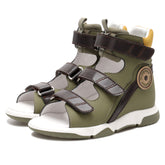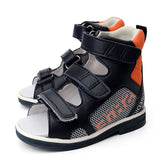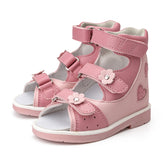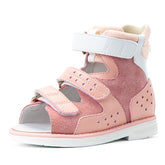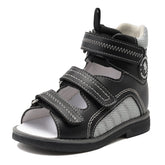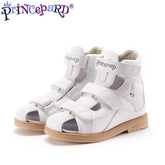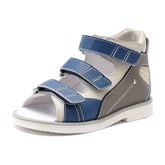How Orthopedic Shoes Work
Orthopedic Shoes: Reshaping Every Step of Healthy Growth with Scientific Molding
-
The Lesson of Square Watermelons: How Molds Reshape Life Forms
In agricultural exhibitions, square watermelons never fail to astonish visitors. These geometrically perfect fruits are cultivated using transparent molds that guide their growth, redistributing sugars within a confined space to form crisp edges. Similarly, orthopedic shoes act as "biomechanical molds" for developing feet. Their three-dimensional support systems redistribute plantar pressure, guiding bones, muscles, and ligaments to grow within optimal spatial parameters.

2. The Golden Ratio Engineered from 10,000+ Healthy Foot Models

In cutting-edge pediatric biomechanics labs, 3D scanners capture the growth trajectories of over 10,000 children’s feet—from toddlers to adolescents. Every 0.1mm shift in arch curvature is analyzed to create data-driven design benchmarks. Key features include:
-
A 15-degree upward angle at the forefoot to absorb impact forces
-
Gradient-density arch support that adapts to dynamic movements
-
A 55-degree heel cup for precise calcaneal positioning
This medical-grade precision, rooted in big data, ensures corrections align with natural growth patterns.
3. Decoding Biomechanical Algorithms
With each step, an orthopedic shoe’s 8-layer composite structure springs into action:
-
Memory foam forefoot pads dissipate 63% of ground impact
-
TPU torsion-control plates guide 30-degree inward rotation during mid-stance
-
Carbon-fiber propulsion boards boost push-off efficiency by 22%
Like an invisible coach, this system continuously corrects abnormal gait patterns through real-time biomechanical feedback.
4. The Smart Material Revolution
Next-gen orthopedic shoes integrate "thinking materials":
-
Thermo-responsive insoles release herbal soothing agents when foot temperature exceeds 36°C
-
Nano-porous membranes expand by 20% during activity for enhanced breathability
-
Piezoelectric fiber networks generate dynamic pressure maps, allowing parents to track progress via smartphone apps
This fusion of IoT and biomechanics transforms correction into a visible, interactive journey.
5. The Countdown for Developmental Intervention
Feet undergo three critical growth phases:
-
18 months: Arch formation begins
-
4 years: Accelerated bone ossification
-
8 years: Structural solidification
Clinical studies published in the Journal of Pediatric Orthopedics show 92% success rates in correcting flat feet when intervention starts before age 12—a 37% improvement over traditional methods. Post-adolescence, bone plasticity decreases by 60%, underscoring the urgency of early action.
From lab prototypes to AI-optimized systems, modern orthopedic shoes have evolved into precision instruments blending biomechanics, materials science, and data analytics. They’re not just footwear, but growth-guarding companions that help children stride toward healthier futures—one scientifically sculpted step at a time.
SHOP NOW : Princepard
